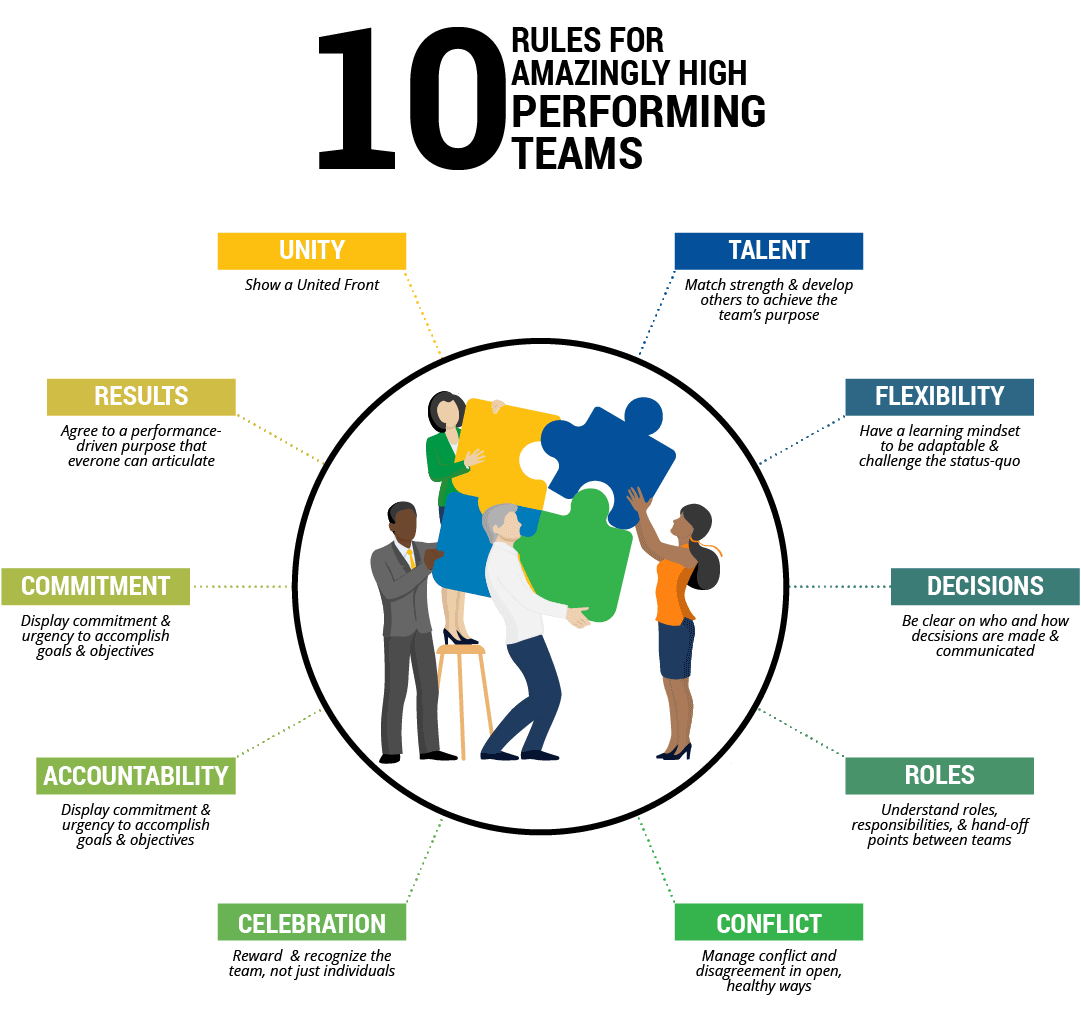Table of Contents
Introduction
1 The Teaming for Success Model
2 What is a High-Performance Team
3 The Three Pillars of a High Performance Team
– Pillar One: Purpose
– Pillar Two: Positive Engagement
– Pillar Three: Communication
4 Building a High Performance Team
5 The Role of a Team Leader
6 Develop and Strengthen Trust
7 Develop and Agree to Operating Principles
8 Clearly Define Roles & Responsibilities
9 Develop Communication and Information Sharing Processes
10 When to Collaborate and When Not to
11 The Role of Conflict
12 Valuing Others: Inclusion, Diversity & Respect
13 How to Lead a Disengaged or Disorganized Team
14 Leading a Remote Team
Conclusion
High
Performing
Teams
Download a Copy to Read Anytime
Download a copy of this webpage as an ebook you can easily refer back to and share with your team.
We know that too many emails can clog up your inbox and make it challenging to get work done. When you share your email with us, we promise to respect your workload and your time.
Introduction
Would you rather have a group of amazing individual players, or a team that works together to consistently deliver results? Most leaders know that a high-performance team provides greater results than a group of star individuals. As Michael Jordan famously said, “Talent wins games, but teamwork and intelligence win championships.”

What’s in a name?
While professional sports offer numerous examples highlighting the importance of great teamwork, let’s consider an example of a superstar filled team from 1992. The roster of the 1992 US men’s Olympic basketball team included Michael Jordan, Larry Bird, Scottie Pippen, Charles Barkley, Magic Johnson, Patrick Ewing, and Karl Malone. Individually, each of these players were some of the greatest all-time players in the sport, and as a result they were nicknamed the “Dream Team” long before they had proven themselves worthy of the name.
In fact, in their first month of practice, these basketball superstars found themselves losing to college players in scrimmage games. Making the adjustment to working together as a team changed their game. Once they committed to learning how to play with each other, rather than playing as individual superstars that happened to be working together, they achieved phenomenal results. They dominated the Olympic competition, scoring over 100 points in every game, and they brought home the gold medal.
“That’s one small step for man, one giant leap for mankind”
~Neil Armstrong
An off-the-court example of the power of teams can be found in NASA’s Apollo 11 mission, the one that put a man on the moon. Spurred on by John F. Kennedy’s 1961 proposal that the “US should commit itself to achieving the goal, before this decade is out, of landing a man on the moon and returning him safely to the Earth,” nearly 400,000 people worked to make the moon landing possible. Scientists, engineers, technicians, and astronauts worked together to achieve an historic and unprecedented victory. By 1969, Apollo 11 delivered three men to the moon and brought all of them back home. The great leap for mankind Armstrong referred to was made possible by large numbers of individuals working together to achieve something that had only been dreamed of before.
Is it any wonder then that leaders at all levels of an organization strive to put together high-performing teams that can achieve large company goals? Or why 90% of investors consider the effectiveness of the management team to be the most important non-financial factor when making a decision to invest in an IPO? Or why there is a nearly 2% increase in the likelihood of having above average financial performance in organizations defined by a top team working together toward a common vision? High-performance teams produce higher quality output at least 80% of the time.
The importance and impact of a high-performance team cannot be overstated – especially when you take the time to build a high-performance executive team. As a team leader, you will set the strategic direction, create the plan, and organize the players. To drive performance as you move forward, you’ll need to be aware of the member’s needs, mentor and coach them, acknowledge performance and contributions, and resolve problems. High-performance teams achieve higher quality output with greater buy-in and fully engage the hearts and minds of employees.
While creating and sustaining high-performance teams isn’t an easy task, as you can see, it is a worthy and accomplishable goal. In this guide, we share the philosophy and process we use at Stewart Leadership to help leaders create and maintain high-performance teams.
Stewart Leadership’s
Teaming for Success Model
Spending most of your professional time working in teams is rapidly becoming the norm across industries, and the need to develop great teaming skills, in addition to leadership skills, is crucial. Professionals today are often on multiple teams at once, and this challenge requires both a new set of skills and an understanding of the different phases of team development.
Most advice on teaming tends to focus on one of two phases in a team’s development – either the advice focuses on how to build the best team from scratch, or the conversation centers around tweaking different elements within an existing team like increasing morale or defining roles and responsibilities.
Many teams are temporary in nature, yet they are charged with fulfilling a mission-critical task. While anyone launching this team will be sure to benefit from the loads of advice out there on forming the best team, if the team is not living up to its potential, isolating the area of challenge becomes exceedingly difficult if the only advice you can find addresses the concerns of a long-term, permanent, and primary team.
We noticed this gap in information and looked deeper into our research and consulting with teams over the past 40 years to understand how we could help cross-functional or temporary teams perform at their highest potential. What we found is that all highly successful teams share common elements.
The Stewart Leadership Teaming for Success Model identifies 9 Teaming Dimensions that describe the teaming fundamentals- the elements that all teams need to consider, develop, focus on, and do well to achieve high levels of effectiveness, cohesion, and performance. Each dimension aligns to one of five phases in the Teaming for Success Model to identify what elements are most critical to success in each phase. No matter what stage of development your team is at, these nine dimensions are the collective competencies that define what great teaming looks like.
We also identified 5 phases of team development recognizing that the order of team development matters. For example, as teams focus on Launching and Aligning, the Trusting and Achieving phases will become stronger and more effective. Our Teaming for Success Model breaks down the phases of team development and notes the essential elements for success at each phase.
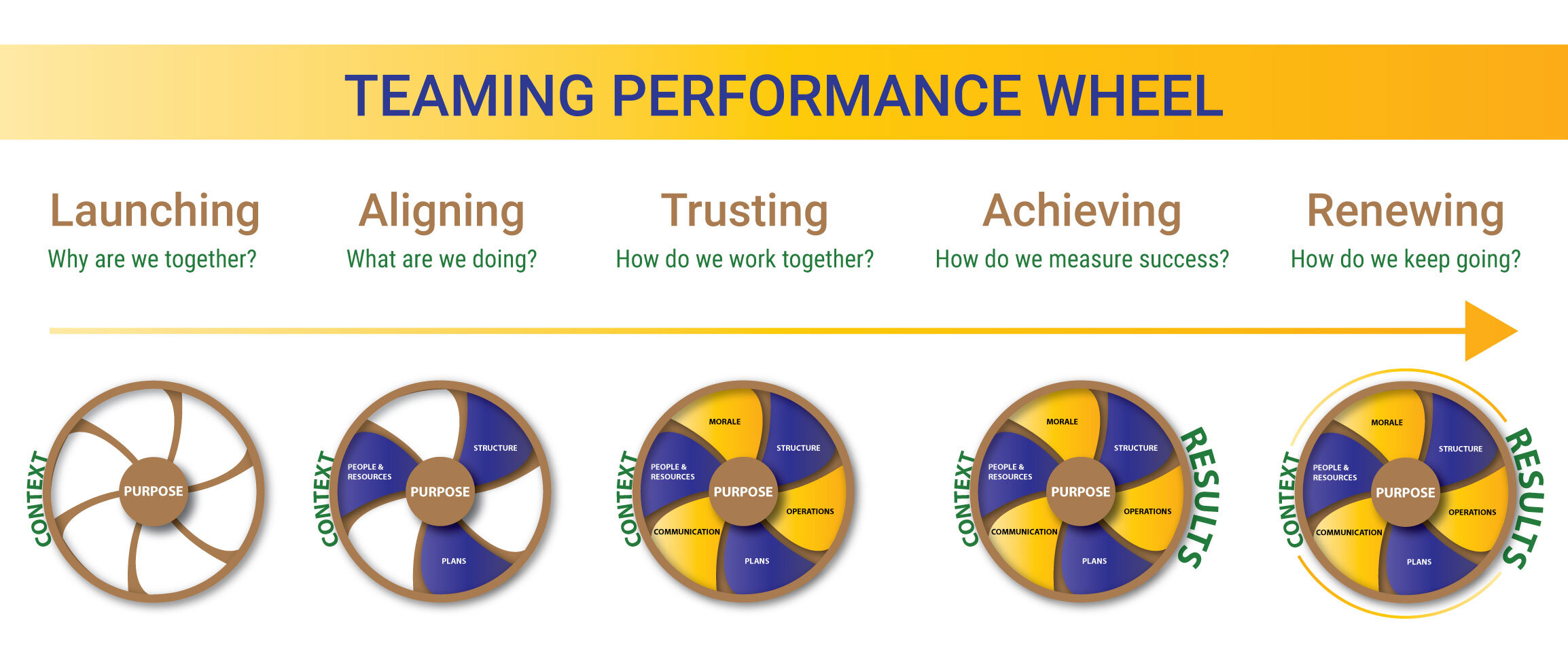
Each phase of the model answers a critical question for the overall team.
Launching
Why are we together?
Defines the team’s purpose and context.
Aligning
What are we doing?
Covers structure, plans, people, and resources.
Trusting
How do we work together?
Emphasizes morale, behaviors, and communication.
Achieving
How do we measure success?
Focuses on obtaining, sustaining, and celebrating results.
Renewing
How do we keep going?
Moves the team forward as they manage and respond together in changing times.
This guide focuses on the development of a high-performance team, and thus covers information that is important for any team.
What is a High-Performance Team?
What is a High-Performance Team?
Teams have three levels of development and high-performance teams represent the pinnacle of team achievement. They are united in purpose, produce sustained results, and share a one-for-all mentality. Every member of a high-performance team knows that everyone wins together or no one wins at all.
High-performance teams are characterized by consistent growth – growth in the organization, in the team, and in the team members. This growth demonstrates that the team is setting high goals and then working together to do what they need in order to achieve them. These teams are proactive rather than reactive; they plan ahead for hurdles and can be nimble in meeting the needs of the business because they are focused on the mission instead of being distracted by emergencies.
In the most amazing teams, the individual accomplishments matter, but the entire team is focused on sharing the credit equally, regardless of what work each individual put into the project in order to achieve the goals. These teams, and their leaders, understand that while individuals can be stars in their own right, the team’s performance doesn’t depend on personnel.
You cannot simply hire your way into a high-performance team. You must build it, nurture it, and maintain it by creating purpose, engaging positively, and communicating constantly.
OTHER QUALITIES OF A HIGH-PERFORMANCE TEAM INCLUDE:
- Excellent and consistent performance results
- Good communication and information sharing
- A welcoming of diverse perspectives
- Growth of new business opportunities
- Processes, structures, and systems aligned to business strategy
- Respect for others is an essential part of the culture
- Team members have high involvement and investment in the outcome
- People are empowered by their leaders
The Three Pillars of a High-Performance Team
Isn’t it fascinating how the results of teams of professionals can range from completely disappointing to stunningly exceptional? Whether it is a team at work, in athletics, at a school or university, or somewhere in the community, team results are all over the place.
Over the past four decades of working with teams of all sizes and levels of responsibility, we have identified three pillars that make the difference between poor, mediocre, and successful teams: Purpose, Positive Engagement, and Communication. We have found that if any one or more of the three pillars are missing, the team will either fail miserably or, at best, perform well below its potential.
Watch John Parker Stewart demonstrate how the three pillars work together
Pillar One: Purpose
Any team requires a purpose. Without a purpose or a mission, there is no reason to have a team because there is no goal to achieve or target to hit.
It seems to make intuitive sense, but all too often we have worked with teams that did not share a common purpose, but rather were full of individuals who brought their own agenda to the team. This is particularly prevalent in executive teams as each member of the team is concurrently leading efforts within the department they run to meet goals there. In our experience, it takes deliberate action to pull executive teams together and it always starts with defining a shared purpose for the team, and the business.

But purpose goes beyond just having an ideal everyone is striving toward. Purpose includes an understanding of how the roles and responsibilities of each team member contribute to the achievement of the mission – a lesson we can learn from great blue herons. A powerful sense of purpose helps prioritize individual goals and imbues even the dullest of tasks with some sense of meaning.
One of the most powerful side effects of having a strong sense of purpose is the willingness of individual team members to forgive one another for having a bad day. When every member of the team feels like they have a reason to be on the team that is bigger than themselves, then the grumpiness or quirks of coworkers feel smaller and are consequently forgiven faster. As everyone on the team feels a sense of ownership for the results, the tendency to get derailed by drama is thwarted; after all, who has the time to focus on something small and petty when the mission matters more?
Pillar Two: Positive Engagement
“It takes ten
hands to
score a basket.”
~Coach John Wooden
Teams that exemplify “Positive Engagement” are those that hold the belief that together we can achieve more than any one of us alone. They are filled with individuals ready and willing to invest in the team and its output. Positive engagement – with the purpose, with each other, and with leadership is a critical, non-negotiable element of every high-performance team.
Unfortunately, it’s also the part of team building that causes most leaders to trip up because many managers or team leaders operate under the belief that they don’t have time for this kind of stuff – because this is the kind of stuff that feels softer or fluffier. It may be a wine and cheese night, a pizza party, or a brown bag lunch to explain what the purpose is all about.
Your willingness to invest your time into getting to know the team and build relationships with, and within, the team is directly correlated to the level of investment your team will have in the purpose.
Pillar Three: Communication
Creating a high-performance team, whether a brand new work group – or most commonly working with an existing team – is as much a change management effort as it is a team building endeavor. John Kotter, one of the world’s foremost experts on change, notes that in order to obtain and maintain commitment to the vision or purpose, one must continuously and effectively communicate the vision. As you lead your team, keep these elements in mind:
- Keep communication simple, direct, focused, and jargon-free.
- Use metaphors, analogies, and examples to bring the message to life.
- Deliver the message across lots of different forums and vehicles
- Repeat. Repeat. Repeat.
- Lead by example. Behavior is the most powerful way to communicate.
- Address inconsistencies and communicate with openness and honesty.
- Remember listening is a two-way endeavor – solicit feedback and encourage questions, arguments, and challenges about the vision. We recommend voicing your opinion last.
These three pillars are foundational to building a high-performance team. Without them, it is unlikely you will be able to unlock the full potential of your team. Once you have established this foundation, know that it is critical to your overall success to build a richer understanding of communication. At its best, communication facilitates the creation of meaning together, establishing roles, responsibilities, and operating rules which become important mechanisms through which team identity, team systems, and team structures are dynamically created and lived.
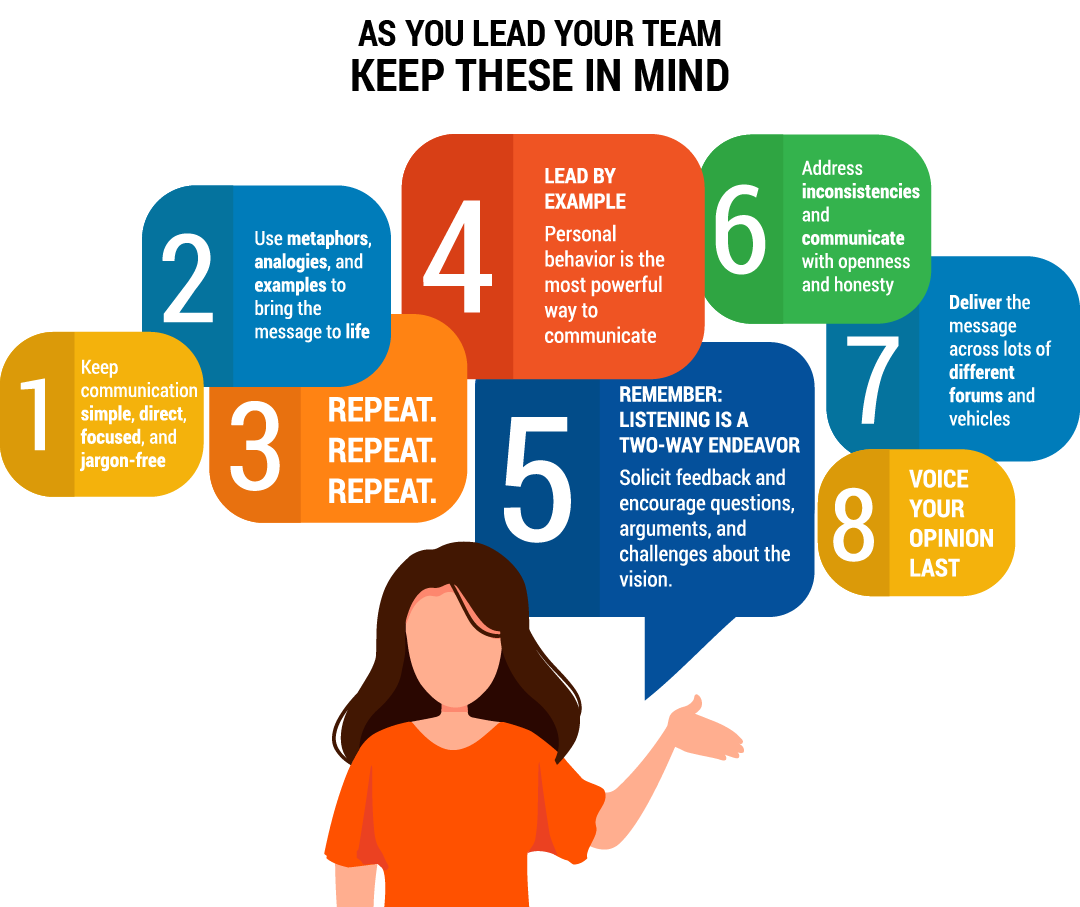
BUILDING A HIGH-PERFORMANCE TEAM
Now that we have defined a high-performance team, and have a solid understanding of the three essential pillars, how do we go about building this team?
Before you can begin any effort to build your team, you must honestly evaluate the teams current state to determine if it is in a state of complete chaos, stability, or already in a high-performance state. We recognize and thank Preston Pond at the Center of Organizational Design for the work in identifying these three levels.
Too often teams put together at work would never be mistaken for a real team. They exist in a state of barely controlled chaos and are, in fact, just a loose group of individuals, each doing their own thing and rarely working together.
Chaotic teams are notable for their lack of consistency. One day they may provide top-notch work, but the next few deliverables are underwhelming. If any of these traits sound familiar, your team may be operating from chaos.

Characteristics of a Chaotic Team
- Inconsistent results; unreliable
- Lack of clear direction and goals
- Constantly shifting priorities
- Reactive, short-term focus
- Noticeably absent processes, structures, and systems
- Unclear policies and procedures
- Lack of collaboration within the team
- Inadequate or unclear people and resources.
If this sounds like your team, you must accept that it will take time to shift this team into a high-performance mode, and you need to set your goals accordingly. This must go beyond setting goals within the team, it needs to apply to every goal your team is asked to achieve. Far too often strong, promising leaders fail to deliver because they underestimated the amount of effort required to shift their team out of low performance. Know that moving the team to a stable foundation will take time. This is a great resource to get started.
If your team does deliver consistent results, you may be working with a team that is in a state of stability. If so, you may look around and think that your team is doing pretty good, but you might sense that something is missing, and if you could just figure out what that is you would be able to dramatically increase your performance.
If this sounds like your team, know that you are halfway to creating a high-performing team, and that you can shift into higher gear by taking specific actions that will get you there.
Characteristics of a Stable Team:
- Consistent performance results
- Processes, structures, and systems in place
- Adequately resourced
- Clear goals and direction
- Consistent priorities
- Well-defined procedures and policies.

Once you know what state your team is currently in, you can begin to formulate a course of action that will shift/move your team into a high-performance state, but you cannot solve the problem until you take the time to define it.
THE ROLE OF A TEAM LEADER
That can be a lot of pressure. If you aren’t up for it, take a moment to consider whether or not you want to be a leader. Certain circumstances, like replacing a beloved manager, can make the role even more difficult at first.
Assuming that you are not only ready, but that you also feel, in some sense, called to a leadership role, then know you must be the model for the behaviors and operating principles you require of your team. If you need them to trust each other, you must start by trusting them. If you need them to respect each other’s roles, you must demonstrate what that looks like. Your attitude toward opportunities, challenges, and everything in-between sets the tone for the team. Make sure it is the tone you want everyone to have.
Leading a team, and especially leading a high-performance team, is a privilege. Once you become a leader, your personal behaviors become integrated with your professional position. In a sense, you are always on stage. Your team will be watching you, scrutinizing your actions to see if you actually uphold the values you espouse. The transition from individual contributor to manager is one of the hardest challenges you will face in your career. Existing relationships will change, and the relationships you have with your direct reports will be different than those you have with other coworkers.
A leader’s attitude cascades through the team as either an inspiring waterfall or a crushing lava flow.
-daniel stewart
develop and strengthen trust
Competence
Your team must be able to count on you and on their team members to do their jobs well. If there is doubt in one another’s competence, then your team will turn away from working together and begin focusing on individual goals to the detriment of team goals. Focus on hiring team members who have the knowledge and skills required to complete their tasks, and if you notice a skills gap, address it immediately with additional training.
Character
Your team members need to be able to respect you and each other. Seek out individuals who have integrity, who have a high degree of reliability, and who display loyalty. Highly skilled team members who act disrespectfully or shirk their responsibility weaken a team. If you see this behavior you must deal with it as soon as you notice it, and replace that team member if the behavior does not change.
Caring
Genuine caring and a clear, heartfelt commitment to doing the right thing for each other is what most of us think of when we think about building trust – and there is a good reason for that. Teams that show each other empathy, check in with each other, and openly discuss risks and impacts are a pleasure to be a part of. This type of caring often develops once the other two Cs have been demonstrated to be in abundance. Provide opportunities for your team to get to know each other, and encourage open discussion of risk. Ask your team members to demonstrate empathy by having them describe the impacts of a result on all parties.
DEVELOP AND AGREE TO OPERATING PRINCIPLES
This is the moment you and your team decide HOW you are going to work together. What are the specific behaviors your team is agreeing to, and how will you hold each other accountable for this work?
We have found that a short series of team building activities with an emphasis on participation is the quickest way to establish operating principles.
Some examples of operating principles we have seen successfully deployed include:
- Articulate the vision in terms that address the “why” and how it applies to each individual team member so all are inspired and engaged.
- Don’t accept the status quo. Validate data, challenge assumptions, and assess risk.
- Make decisions based on alignment with strategy.
- Invite and respect active diversity of thought without retribution. Encourage active debate in private; display unity of purpose in public.
- In a timely manner, communicate decisions/actions with affected stakeholders to build and maintain trust within and/or outside the team.
- Display passion and urgency to accomplish objectives.
- Follow up on actions to ensure completion and/or course correction.
- Develop ourselves and our people.
- Manage conflict and disagreement in open and healthy ways.
- Be respectful, build trust, and keep confidences.
Once you have developed and agreed to operating principles, use the document as a guide to hold yourself and your team members to this standard. Solicit feedback on your behaviors and whether or not they live up to and exemplify the behaviors associated with your operating principles. Encourage each team member to call out good behaviors and candidly discuss the bad in each other.
CLEARLY DEFINE ROLES & RESPONSIBILITIES
Knowing what you are expected to do, and what you can count on your team members for, are critical in keeping employees happy and engaged while forming a high-performance team. This is more than general team rules or operating principles. This clarifies functional and technical responsibilities for initiatives, budgets, and day-to-day activities. It also clarifies who needs to be informed or consulted about certain topics or decisions and who has single or shared decision-making authority.
The Hotshots
The wildland firefighting team known as The Hotshots provide an incredible example of how powerful clearly defined roles and responsibilities can be.
No wildfire is routine, and The Hotshots deploy to the hottest parts of a fire in order to create firebreaks by digging trenches, constructing lines, and clearing brush from encroaching fires. Working this close to something as deadly and unpredictable as a wildfire requires the team to have a deep understanding of their individual roles. With no time for a quick meeting before action is required, team members must be able to count on each other to handle their responsibilities in order to keep everyone on the team safe. Each individual is empowered to take immediate action within their area of responsibility and they know exactly which team member to turn to for assistance in any eventuality. For The Hotshots, defined roles and responsibilities keep them alive.
In most teams, the stakes aren’t as high, but the impact of clearly defined areas of responsibility can be just as dramatic. Here are some ground rules to get you started:
- Identify the single or shared points of contact for each project or initiative
- Clarify who has decision-making authority for each effort and who else needs to be informed or consulted before a decision is made
- Structure leadership roles by how value is created in the organization (by customer, product, geography, function, or combination)
- Identify the competencies required for success and create roles designed around the competencies rather than existing individuals
- List out the behavioral markers required for success in each role; resist the temptation of designing roles around existing team members
Develop Communication and Information Sharing Best Practices
It is frighteningly common for individuals to assume that because they know something everyone else does too. It is also frighteningly common for individuals to assume they know everything they need to know or else someone would have told them. And it’s these small assumptions that result in the biggest communication errors.
Not sharing information adequately leads to misunderstandings, a sense of playing politics rather than supporting the team mission, and an erosion of trust.
You can circumvent this common challenge by defining some best practices around communication and information sharing such as determining what information must be shared and how to share it.
Ask these questions:
- What can be shared via email?
- At what point is a meeting required and what must be shared at the meeting?
- Can employees use alternate methods of communicating and if so, where is the appropriate place for that? Many companies use Slack or other internal chat tools and in these instances defining what channels can be used and who must be included is appropriate.
- Where is all the information stored? Is it an internal server? A Dropbox folder?
- What communication requires a response and what is the acceptable interval of time for that response to arrive by?
When to Collaborate and When Not to
One of the most common goals senior leaders share with us is a desire for their managers to collaborate more, but overusing and overvaluing collaboration can create disengagement, loss of productivity, and cynicism. All of which are warranted when collaboration becomes its own goal, done simply for the sake of saying it has been done.
When used effectively and in the right situations, collaboration can help teams accomplish amazing results. The Focused Collaboration Model, developed based on the ideas shared by Morten T. Hansen in his 2009 book, Collaboration, can be used to help you know when and how a collaborative approach should be used.
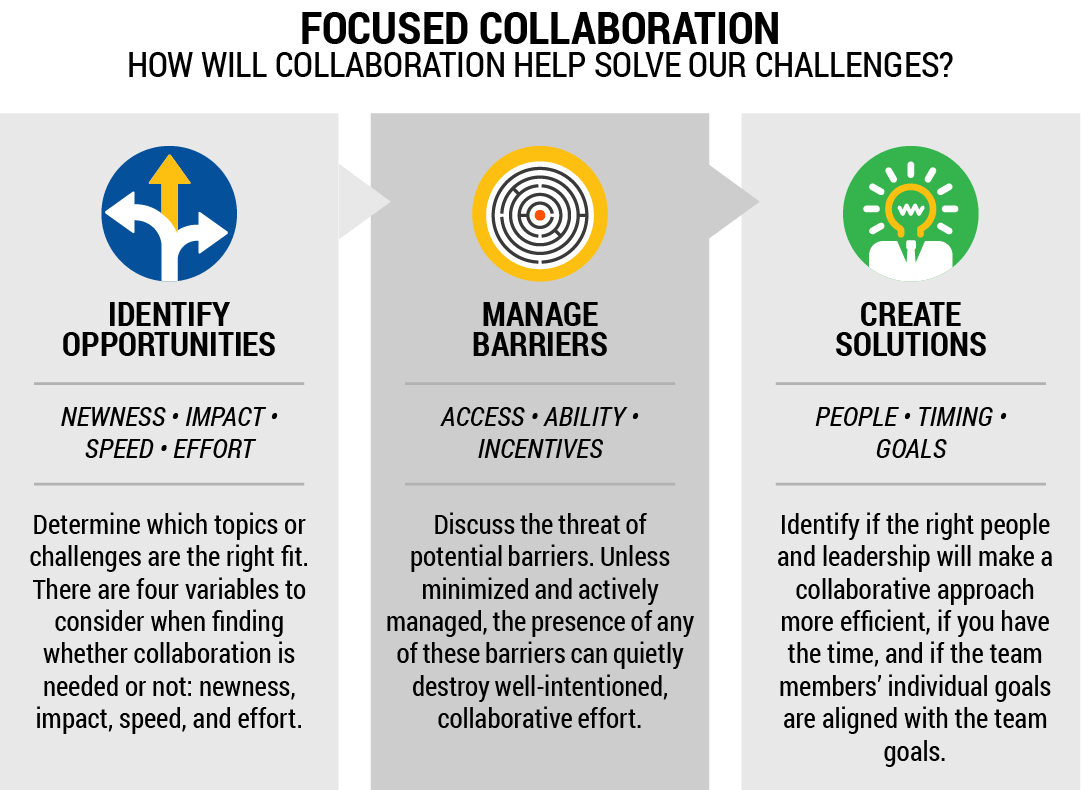
When engaging collaboratively with your team, remember that there will come a point when a decision needs to be made. Let your team know that you will be held accountable for the decision, which means you must be responsible for the decision. This will help negate the tendency to make decisions by committee or achieve full buy-in before moving forward.
Listen to your team when they collaborate, voice your opinion last, and choose the solutions that respect the entire process, but that match the need best. Sometimes this means you will be disappointing your team by not using every suggestion offered. Sometimes this means you may have less support for your decisions at first than you would like.
With every change there will be a period of time where everything feels uncomfortable. Set the expectations around collaboration and final authority up front and keep your word. When you act knowing that you will be responsible for the results, and your team sees your willingness to be accountable for the work, then you will earn a team of collaborators focused on achieving the same goals.

Knowing he was elected president by a minority of the population, Lincoln strove to create a diversity of opinion within his cabinet and included his main rival for the presidency, William Seward, as well as the leader of a more radical wing of the party Salmon Chase along with others as part of Lincoln’s “Team of Rivals.”
Few teams have the kind of pressure put upon them as Lincoln’s cabinet did. The country was ripping apart at the seams, and each man cared about the results and represented an idea or set of ideas that he felt would be the best course of action.
Realizing that all opinions needed to be taken into account, Lincoln encouraged division and dissent in order to hear all of the opinions. He asked his team to work together to come up with solutions. But he often let them down by making a decision that was not in line with their advice.
Lincoln knew that he was responsible for the final decisions, and although it frustrated his team over and over again, they came to trust Lincoln’s judgment.
The Role of Conflict
It’s easy to fall into the trap of thinking that conflict is either all bad or all good. In some prominent start-up cultures, confrontational employees are rewarded with the thinking being that conflict spurs innovation and innovation spurs growth. In other business cultures, confrontation is understood as something to be avoided in order to ensure every voice is heard.
In highly confrontational cultures, it’s relatively easy to slip into creating hostile work environments where many employees hide in their shell. These cultures promote a winner-take-all culture that often leads to reckless behavior. In teams with high conflict levels, the short-term tends to take a greater share of the attention as conflict generally revolves around what can be solved right now. This is great for increasing sales and growth, but terrible for creating long-term sustainability.
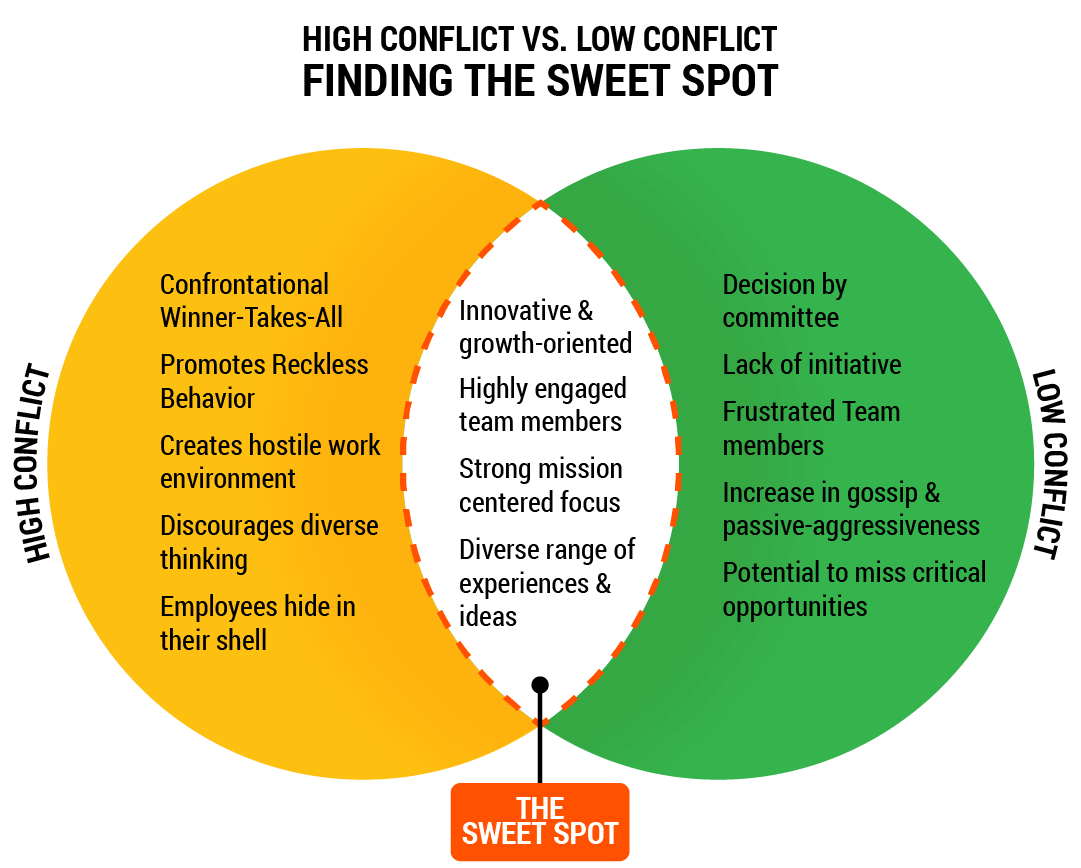
As a team leader, your first task will be modeling how to handle conflict well. It’s critical that you strive to create an environment which promotes open discussion and encourages dissenting viewpoints as long as they remain respectful. Encourage a diverse range of voices by including people with different backgrounds and experience levels to bring some variety and fresh viewpoints. You will want to elicit input from everyone, make sure you voice your opinion last, and set time limits around discussions or an end point in which a decision simply must be made.
Valuing Others: Inclusion, Diversity, & Respect
If you desire fast problem-solving, increased innovation and creativity, and a higher level of engagement with the mission, you can get there much faster by intentionally including diverse viewpoints and perspectives.
Teams populated with individuals who have different viewpoints and come from different backgrounds are much less likely to be mired in groupthink. They solve problems faster because they bring a variety of ideas, which enables them to choose the best solution sooner.
Inclusion, or a feeling of belonging, matters on every team. When you create a space for the expression of ideas without allowing a sense of judgment to creep in, employees can shift their performance into high gear. Instead of being worried about how they are perceived in the workplace, team members who feel included can focus on executing tasks to the best of their ability.
So how can you foster this sense of inclusion? Return to Pillar Two: Positive Engagement, and build those relationships. Create a space for your employees to get to know each other as well. Know that checking in on your employee’s well-being is the most powerful way to tell them you care, and to keep them engaged with the mission. You cannot achieve amazing performance without putting in the effort to build the relationship. Checking on team member’s well-being, and specifically getting a sense for how included they feel, is the most powerful way to tell them you care.
As you build a diverse, inclusive team, you will need to set the tone for respectful dialogue. As the team leader, you have a responsibility to create a space in which everyone can feel respected. One of the most effective ways to model this is to demonstrate self-respect. A self-respecting individual doesn’t feel the need to criticize other teams or individuals, and when you demonstrate how to do this, your team will follow your lead. Remember, although you may not be responsible for the overall culture of your organization, you create your team culture.
Special Considerations: How to Lead a Disengaged or Disorganized Team
Most high-performing teams don’t start out that way. In fact, leading a disengaged or disorganized team is a more common leadership experience than leading a high-performance team.
First identify if you have a down and out team or a disorganized team, and be prepared to speak frankly with your team about its current state and how to move forward.
In the case of a discouraged team, deal head-on with whatever has caused the team to lose heart. Let the team know that you understand where they are coming from before you ask them to leap into high gear. Often, a discouraged team feels unappreciated or under-valued and when you begin your tenure as their team leader, identifying the good things and demonstrating that you are willing to go to bat for the team will smooth your transition. Managing a down-and-out team is not a quick fix, and you will need to cultivate a focused type of team leadership to manage past disappointments while motivating the team to continue.
In the event you are taking over a disorganized team, you must spend time working on the fundamentals before you can soar to great heights. A disorganized team has a greater need for structure so begin by following these seven steps.
Special Considerations: Leading a Remote Team
When the Covid-19 Pandemic hit millions of organizations became fully remote in a matter of weeks and the challenges of leading a remote team quickly became apparent. Everything from celebrating success to having difficult conversations was thrown into a world we could see coming, but were not fully prepared for. We had a crash course in mastering behaviors required of successful remote leaders, and how to maintain our sharpness and sanity while working from home.
As we move forward we can expect that some teams will remain fully remote and many will function in a hybrid manner. Knowing how to approach and lead remote teams will be critical for team success.
These are the top 3 teaming dimensions we have identified as crucial to developing a remote high-performance team.
Structure
Remote teams must emphasize structure in order to be successful. The best remote teams have a structure designed to provide each team member with added flexibility so they can work when they are most productive, or so they can step in to handle some domestic responsibilities during traditional work hours. Remote workers typically place a high value on flexibility, but in order to function effectively as a team, a shared structure such as designated meeting availability and an insistence on the use of video during meetings will help prevent power struggles while building a sense of team unity and consistent expectations.
Communication
Communication is the single most important strategy in developing a high-performing remote team. Teams that work in a shared space have the advantage when it comes to communication. Quick conversations can be had in the break room, walking past someone’s office may prompt a reminder to share an important tidbit, and co-workers have more opportunity to chat. Remote teams must compensate for this loss by deliberately over-communicating. Determine the methods you will use to ensure everyone can access any information that might be important, be vigilant in ensuring that you have thoroughly communicated the expectations for remote workers, and take extra time in team meetings to let everyone ask questions. Oftentimes the information one team member needs to do their job isn’t the information everyone else remembers to ask for.
Leaders of remote teams should prioritize scheduled check-ins with individual employees and with the team. Scheduled check-ins are more important than frequent check-ins – just make sure you create a schedule you can commit to! These check-ins do not need to be, and should not always be, strictly about work. It’s encouraged to make some small talk in order to promote psychological safety on your team.
Results
When leading a remote team it’s even more critical to focus on the “what” rather than the “how.” In fact, remote teams generally require greater latitude in how and when work is completed. When you assign work to your team members check that they understand what needs to be accomplished and why it is important, and then let them run with it.
By focusing on results you will be tapping into the power of intrinsic motivation and you will inspire commitment. Your team members will feel a greater sense of ownership for the end result, they will be more engaged, take pride in the results, and appreciate the trust you have in their ability to solve problems.
Conclusion
We have all had too many experiences being a part of a bad or mediocre team. Let’s create teams that offer an enlivening experience. If you are committed to creating an amazingly high-performing team and achieving the remarkable results you desire, you can and will achieve it.
Over the years in working with thousands of leaders we created a ten-point list you can use to establish accountability for yourself and all the team, and set expectations. You can refer to this list to identify problems, find solutions, and celebrate team wins.
